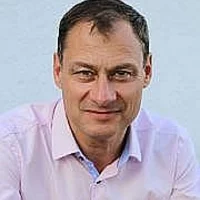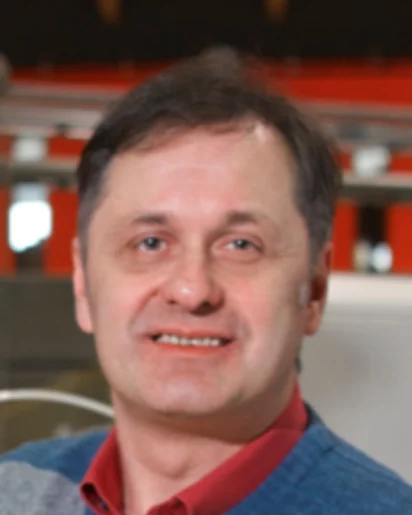Biography
Vladimir N. Strocov has graduated from the Physics Faculty of St. Petersburg State University (Russia) and defended his PhD degree with the Research Institute of Physics of St. Petersburg State University. The scientific carrier was followed by multiple periods of research work with Chalmers University of Technology (Sweden), Universität des Saarlandes (Germany), Université de la Méditerranée (France) and Universität Augsburg (Germany). The research focused on development of the experimental and theoretical methodology of Very-Low-Energy Electron Diffraction (VLEED) as a spectroscopic method to probe the dispersions and lifetimes of the photoemission final states. This information is of vital importance for reliable determination of three-dimensional electronic dispersions from the Angle-Resolved Photoelectron Spectroscopy (ARPES) experiment. The habilitation (senior doctorate) thesis was defended with the Institute of Analytic Instrumentation, St. Petersburg. Since 2004 a beamline scientist at the group of Spectroscopy on Quantum Materials, Photon Science Division of Paul Scherrer Institute, with the instrumental and research activity focused on soft-X-ray ARPES at the Swiss Light Source synchrotron radiation facility. This activity has resulted in pushing the soft-X-ray ARPES technique to previously unthinkable applications to electronic structure of buried nanostructure and impurity systems actual for electronic, spintronic and quantum devices. As of the end of 2023, more than 260 publications in refereed journals and monographs. Since 2023 reading the course on Electron Spectroscopy (master and PhD student grade) at the University of Zurich.
Institutional Responsibilities
Leading scientific projects on soft-X-ray Angle-Resolved Photoelectron Spectroscopy (ARPES) with its main applications to electron correlations, 2D and 3D materials, heterostructures and impurity systems. Leading design, construction, commissioning, software and operation of the high-resolution soft-X-ray beamline Advanced RESonance Spectroscopies (ADRESS) beamline at SLS including the ARPES endstation. Optics design of high-resolution beamlines and X-ray spectrometers. Leading development of the energy- and angle-multichannel spin analyzer iMott. Support of the soft-X-ray ARPES users.
Scientific Research
Electronic structure of quantum materials (bulk materials, nanostructures and impurity systems) including the dynamic many-body properties and electron-boson coupling. Experimental studies using electron and X-ray spectroscopies supported by computational analysis. X-ray and electron spectroscopy instrumentation (synchrotron-radiation beamlines, high-resolution X-ray and electron spectrometers). The experimental studies focus on ARPES in the soft-X-ray photon energy range. This technique combines the electron-momentum resolution of ARPES with enhanced photoelectron escape depth, concomitant sharp definition of the three-dimensional momentum, and resonant photoexcitation delivering elemental and chemical state specificity. The advanced instrumentation at the ADRESS beamline has allowed stretching this technique to the most photon-hungry cases of buried nanostructures and impurities, which are at the heart of modern electronic, spintronic and quantum devices. An ongoing project on the high-efficiency multichannel spin detector iMott will allow access to spin texture of buried nanostructures and impurities. The materials of particular interest include (1) strongly correlated transition-metal oxides (cuprates, titanates, etc). New non-trivial quantum states emerging in their heterostructures offer new functionalities for future quantum devices; (2) Semiconductor interfaces with other semiconductors, topological materials and superconductors, with the latter promising realization of Majorana-fermion based cubits for topologically quantum computing; (3) Magnetically doped semiconductors and topological materials, where resonant soft-X-ray ARPES resolves embedding of the impurity states into the host electronic structure.
Selected Publications
High-resolution soft X-ray beamline ADRESS at the Swiss Light Source for resonant inelastic X-ray scattering and angle-resolved photoelectron spectroscopies. V. N. Strocov, T. Schmitt, U. Flechsig, T. Schmidt, A. Imhof, Q. Chen, J. Raabe, R. Betemps, D. Zimoch, J. Krempasky, X. Wang, M. Grioni, A. Piazzalunga & L. Patthey, J. Synchrotron Rad. 17 (2010) 631
Concept of a spectrometer for resonant inelastic X-ray scattering with parallel detection in incoming and outgoing photon energies V. N. Strocov, J. Synchr. Rad. 17 (2010) 103
Soft-X-ray ARPES facility at the ADRESS beamline of the SLS: Concepts, technical realisation and scientific applications. V. N. Strocov, X. Wang, M. Shi, M. Kobayashi, J. Krempasky, C. Hess, T. Schmitt & L. Patthey, J. Synchrotron Rad. 21 (2014) 32
Fermi Surface of Three-Dimensional La1−xSrxMnO3 Explored by Soft-X-Ray ARPES: Rhombohedral Lattice Distortion and its Effect on Magnetoresistance. L. L. Lev, J. Krempaský, U. Staub, V. A. Rogalev, T. Schmitt, M. Shi, P. Blaha, A. S. Mishchenko, A. A. Veligzhanin, Y. V. Zubavichus, M. B. Tsetlin, H. Volfová, J. Braun, J. Minár & V. N. Strocov, Phys. Rev. Lett. 114 (2015) 237601
Fermi states and anisotropy of Brillouin zone scattering in the decagonal Al–Ni–Co quasicrystal. V. A. Rogalev, O. Gröning, R. Widmer, J. H. Dil, F. Bisti, L. L. Lev, T. Schmitt & V. N. Strocov. Nature Comm. 6 (2015) 8607
Concept of a multichannel spin-resolving electron analyzer based on Mott scattering. V. N. Strocov, V. N. Petrov & J. H. Dil, J. Synchr. Rad. 22 (2015) 708
Polaronic metal state at the LaAlO3/SrTiO3 interface. C. Cancellieri, A. S. Mishchenko, U. Aschauer, A. Filippetti, C. Faber, O. S. Barišić, V. A. Rogalev, T. Schmitt, N. Nagaosa & V. N. Strocov, Nature Comm. 7 (2016) 10386
Entanglement and manipulation of the magnetic and spin–orbit order in multiferroic Rashba semiconductors. J. Krempaský, S. Muff, F. Bisti, M. Fanciulli, H. Volfová, A. Weber, N. Pilet, P. Warnicke, H. Ebert, J Braun, F. Bertran, V. V. Volobuiev, J. Minár, G. Springholz, J. H. Dil & V. N. Strocov. Nature Comm. 7 (2016) 13071
Weakly-Correlated Nature of Ferromagnetism in Nonsymmorphic CrO2 Revealed by Bulk-Sensitive Soft-X-Ray ARPES. F. Bisti, V. A. Rogalev, M. Karolak, S. Paul, A. Gupta, T. Schmitt, G. Güntherodt, V. Eyert, G. Sangiovanni, G. Profeta & V. N. Strocov. Phys. Rev. X 7 (2017) 041067
Orbital ordering of the mobile and localized electrons at oxygen-deficient LaAlO3/SrTiO3 interfaces. A. Chikina, F. Lechermann, M.-A. Husanu, M. Caputo, C. Cancellieri, X. Wang, T. Schmitt, M. Radovic & V. N. Strocov. ACS Nano 12 (2018) 7927
k-space imaging of anisotropic two-dimensional electron gas in GaN-based high-electron-mobility transistor heterostructures. L. L. Lev, I. O. Maiboroda, M.-A. Husanu, E. S. Grichuk, N. K. Chumakov, I. S. Ezubchenko, X. Wang, T. Schmitt, M. L. Zanaveskin, V. G. Valeyev & V. N. Strocov. Nature Comm. 9 (2018) 2653
Electron-lattice interaction boost on the verge of metal-insulator transition in oxides. M.-A. Husanu, L. Vistoli, C. Verdi, A. Sander, V. Garcia, J. Rault, F. Bisti, L. L. Lev, T. Schmitt, F. Giustino, A. S. Mishchenko, M. Bibes & V. N. Strocov. Communications Physics 3 (2020) 62
hv2-concept breaks the photon-count limit of RIXS instrumentation K. Zhou, S. Matsuyama & V. N. Strocov. J. Synchrotron Rad. 27 (2020) 1235
Band-Order Anomaly at the γ-Al2O3/SrTiO3 Interface Drives the Electron-Mobility Boost. A. Chikina, D. V. Christensen, V. Borisov, M.-A. Husanu, Y. Chen, X. Wang, T. Schmitt, M. Radovic, N. Nagaosa, A. S. Mishchenko, R. Valentí, N. Pryds & V. N. Strocov. ACS Nano 15 (2021) 4347
Momentum-resolved electronic structure and band offsets in an epitaxial NbN/GaN superconductor/ semiconductor heterojunction T. Yu, J. Wright, G. Khalsa, B. Pamuk, C. S. Chang, Y. Matveev, X. Wang, T. Schmitt, D. Feng & V. N. Strocov. Sci. Advances 7 (2021) eabi5833
High-energy photoemission final states beyond the free-electron approximation V. N. Strocov, L.L. Lev, F. Alarab, P. Constantinou, X. Wang, T. Schmitt, T. J. Z. Stock, L. Nicolaï, J. Očenášek & J. Minár. Nature Communications 14 (2023) 4827
Books
Spectroscopy of Complex Oxide Interfaces: Photoemission and Related Spectroscopies. Eds. C. Cancellieri and V. N. Strocov, Springer Verlag (2018)


